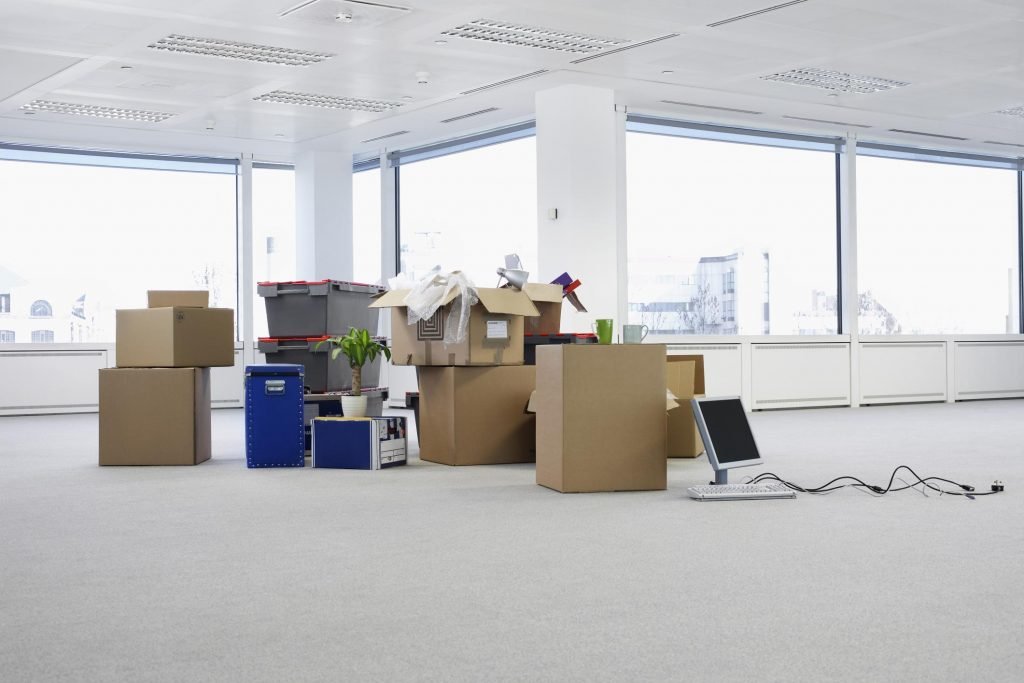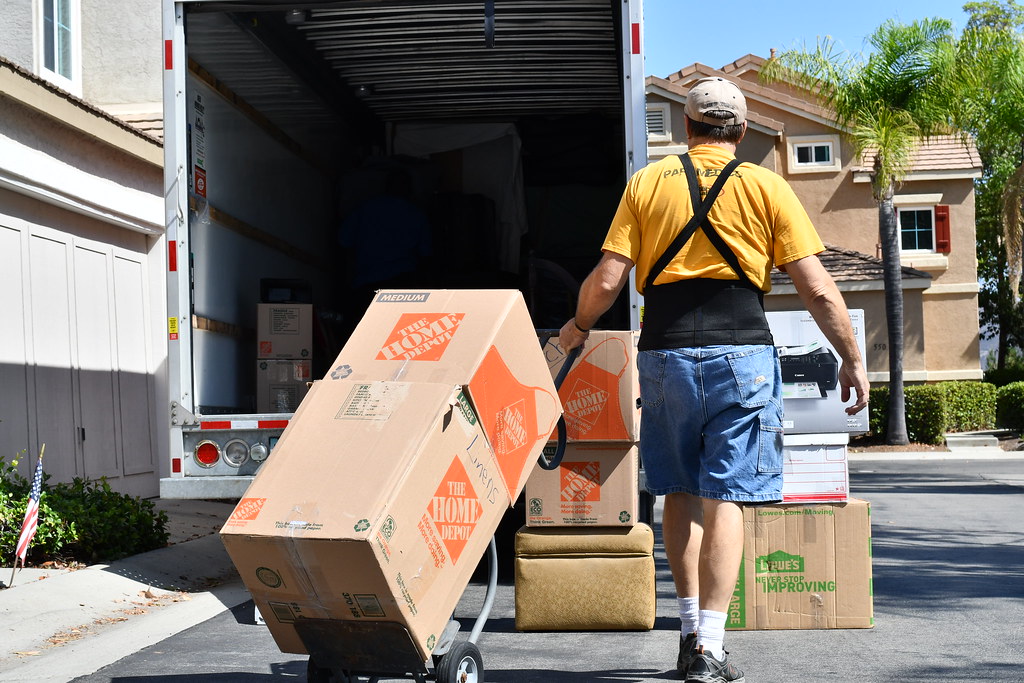If you’re planning to relocate your office, you’re probably full of questions about commercial moving. With so many people, logistics, and equipment involved, you have quite a task ahead of you. But we’re here to help. We’ll go over many aspects of an office move: elements of initial planning, advice for making announcements about the move, steps for packing and moving, and advice for after the move. By the end, you’ll have a comprehensive overview of how to move an office!
Table of Contents
Initial Planning
Start planning your office move at least six months in advance—even before you’ve settled on a new space. During this time, you have a variety of logistics to nail down: budgeting, setting a moving timeline, forming a moving team, choosing a new space, and mapping out your offices.
Budgeting
One major consideration is your budget for the move. Office moves come with a variety of costs. Some of these costs relate to moving services; you’ll need to hire office movers and possibly other companies to help with packing and moving, IT relocation, and transportation.
Other costs include the costs of any additional equipment you’ll buy for the new office and the cost of hiring cleaning services for both offices. In addition, you might need to pay staff to work overtime, and you might need to pay fees for terminating your lease early. Lastly, consider getting moving insurance, which adds another expense.
Having a solid plan for your budget can help you make decisions throughout your move. Also have a plan for how you’ll pay for moving-related expenses, whether it be on a company credit card, or via some other method. Figure out if you want to appoint someone to approve purchases, as well as whether or not you’ll require invoices for expenses.

Setting a Timeline
You also need to set a timeline for your move. Determine your key moving dates. Include dates like when your current lease ends, when you want to sign a new lease, when you want to move, and when you hope to finish the move.
Sketching a timeline will help you coordinate with the many parties involved in the move, including movers, vendors, and employees. As you create your moving timeline, consider what timing fits best with your schedule and minimizes disruptions to workflow.
Forming Your Office Moving Team
As you plan to move your office, you should designate a moving team. This team can be led by a moving point person, either someone already within your company or an external office moving consultant.
Later on, other team members may include representatives from the moving company, IT, HR, and people like interior designers. Now that you have a team, you can keep a centralized record of all information related to the move, including contracts and schedules.
You should also get started on making your office moving checklist to help you stay organized. Divide up the tasks on this list so everyone knows who’s doing what throughout the moving process. For example, you might want to have different people in charge of steps like planning, packing, unpacking, and decorating.

Choosing a New Space
Next, consider your new office space. There are many factors to consider when picking a space. How big is your company? Will there be room for you to grow in the new office?
What kinds of comforts and amenities does the new office have? For example, look for whether the office has features like high-speed internet, private conference rooms and offices, and mail services.
What’s the surrounding neighborhood like? Are there meet-up spots nearby for work lunches? Lastly, how easy is the office to access? All these factors will influence the experiences that your team members have in the new office.
After you have a new space, determine if you’ll need to renew your current lease or not.
Mapping Your Offices
Once you have a new space, it’s time to make some maps. First, map out your current office set-up, including all your team members and major furniture and equipment. To make your life easier down the line, color-code equipment according to who it belongs to.
Then spend some time mapping out your new office space. Don’t forget to include building amenities like ethernet connections in the floor plan, as these will help determine where you want your employees to be located.
Throughout this process of mapping out a new office, solicit feedback from team members regarding their preferences. For example, if they have preferences about noise levels or meeting spaces, consider these. Also ask if they have recommendations for design or seating arrangements, or any needs for specific equipment.
After you’ve finished a map of the new set-up, get employee feedback once again before finalizing anything.

Looking to move soon?
Check out UniMovers and save 30-50% on your move as compared with traditional moving!
Communicating About the Move
Making the Moving Announcement to Employees
Make an announcement about the office move to your employees as soon as possible. First, send an office moving announcement via email. Include details like the reason for the move, the location of the new office, the date of the move, and the design and amenities of the new office. In addition, if you’re moving somewhere that will require employees to relocate, give plenty of details about relocation packages.
After you’ve sent out an initial office moving announcement, follow it up with a meeting. Keep sending periodic updates and reminders about the office move.
Also, give important details such as employee responsibilities during the move. For example, will employees be responsible for packing up their desks? What about work-issued computers? Be very clear in your instructions. For example, you might want to have employees clear out their desks, pack up loose items like paper clips, empty and lock file cabinets, and take home any items that they’ve brought to work.
Closer to your moving day, hold another meeting to go over other office moving announcements. Make sure everyone is informed about information like where they can park and how they can access their offices, what the surrounding neighborhood is like, what the new layout is like, and how their routines may change during and after the move.

Making the Moving Announcement to Others
Your employees are the first people who need to know about the office move, but it affects plenty of others as well. One group of people to make office moving announcements to are your customers and vendors. If you’re moving into a bigger space, this moving announcement can be a great chance to celebrate the growth of your company!
As you make office moving announcements, update all your informational materials, including your address on your website or online. Order new copies of marketing materials like stationary.
Also notify anyone who provides services to you, including the post office, any relevant government departments, your phone and data providers, and any ongoing subscription services you have.
Let your landlord know when you’ll be moving out of your current office space. In addition, get in touch with any vendors you’ll need services from during the move. These may include interior designers or cleaners who can help clean both your old and your new offices.

Workflow Planning
You’re probably eager to minimize disruption to your workflow during the move. Strategize so that you can keep your workflow going strong, especially during the busiest periods of the move: the physical relocation, and the relocation of IT.
Consider having more managerial involvement around the time of the move to help keep the team on track to meet its deadlines.
Also, consider the timing of any new projects you take on. For example, you can plan to finish major projects before the move and negotiate so new projects start after the move. You can also plan the move so that it occurs during off hours or less busy periods.
In addition, be proactive when it comes to backing up data and relocating your IT. You can also try moving in phases or providing temporary workspaces for your staff during the transition if needed. Temporary work options include remote work, co-working spaces, and temporary offices.
Packing and Moving Your Office

Another major part of an office move is tasks related to packing and moving. We’ll go over some of the main parts of the packing and moving process now.
Hiring Movers
For such a large move, you want to find a reliable moving company. Aside from finding a company you trust, make sure to hire movers who specialize in this kind of transport; commercial moves require special skills.
Also, pay attention to the services different companies offer. For example, UniMovers helps with the labor of packing and unpacking in addition to helping with the move itself.
Research moving fees, and get quotes from any companies that look good. Get at least a few different quotes so that you can find a company that’s within your budget. Maybe a more affordable, labor-only company like UniMovers is right for you, or maybe another company will better serve your business.
Remember that movers can’t do everything. There are a variety of items many movers won’t move. Of these items, some are common in offices, including plants, cleaning supplies, and valuable items, which movers may not transport for liability reasons. Have a plan to move these items.

Ordering Supplies
Think about the supplies you’ll need for the move. Create an inventory of what you already have and what you need. You probably already have some supplies like scissors and tape. However, you’ll probably need other materials like boxes.
You don’t necessarily need to buy everything; look into ways you can get packing materials for free. For example, many big retail stores end up with large numbers of boxes that they’re willing to give away.
Packing
Packing for an office move is difficult. Begin the process by creating an inventory of everything you have, and figure out what you’ll get rid of. An office move can be a great opportunity to do some decluttering; for example, if you have files you’ve been meaning to digitize, get it done now. This might also be a good time to replace any outdated items.
Next, decide whether you’ll need to store any items during the move. If so, coordinate storage for these items.
Come up with a system for organizing boxes and equipment according to who they belong to and where they will go in the new space. For example, you can make a spreadsheet of all the items you have, including information like when it’ll be moved, what it is, what it looks like, who owns it, where it currently is in the old office, and where it’ll go in the new office. After you make this spreadsheet, create labels for all your boxes indicating where they’ll go in your new office.
Also, consider taking some non-essential equipment over to the new office yourself before moving day. Keep track of which boxes you plan to move, and which boxes you want movers to take care of. Moving some non-essentials over in advance can simplify your life later.
As you pack, mark boxes with fragile equipment. Pay special attention to your IT equipment: back up everything, and take pictures of the set-up before you disassemble it to make your life easier down the road.

Preparing the Offices
Depending on the terms of your lease, you’ll probably be responsible for restoring your old office to its original condition before you move. Therefore, come up with a plan for removing any kinds of installations you’ve made, as well as features like logos. Survey the space for damages you need to repair before moving out.
You might also have changes you want to make to your new office. There are some basic services like internet, utilities, garbage pick-up, and security to figure out. Make sure you’ve redirected your old phone numbers as well!
In addition, maybe you want to install power outlets, knock down walls, or run networking cables in the office. Plan ahead for getting this work done; making changes before you move in will make the work much easier. Also determine what new equipment, if any, you need after the move. Figure out where and how you’ll purchase it.
Lastly, make sure you have both the old office space and the new office space professionally cleaned before the move.

Office Moving Day Preparation
As moving day approaches, come up with a specific schedule for the arrival and departure of the moving trucks. In addition, shortly before moving day, review your moving schedule with the moving team. Remind your employees to pack. Begin to collect employees’ old keys, and issue them new ones.
In addition, if you have an IT department, they’ll probably be heavily involved during this period; they’ll need to disconnect technology.
The day you move, meet your movers at the old office. Do a final walkthrough with them to make sure they know what they’re moving and that you haven’t forgotten anything. Make a list of emergency contact numbers for them in case they need to get in touch with someone during the move.

Setting Up After Moving Your Office
Unpacking
With all the time you’ve spent organizing the move, don’t slack now! Make sure your unpacking process is organized.
After you move your office, take an inventory of everything in your new space to make sure you aren’t missing any boxes. Figure out who will be responsible for unpacking and setting up what items and equipment.
Once each box is in the right place, begin by setting up furniture and equipment. Having the basics in place first will allow you to resume your work as fast as possible. Next, you can arrange all your files and documents.
Testing Building Features
Before you officially move into your new office, test out the features of the building. Features to check for include network connectivity, audio and video systems, alarm systems, and security systems.
Rewarding Employees
Lastly, after you’ve set up your new office, take some time to reward your employees. One idea is to throw them an office warming party. This party can be a great time for everyone to settle into the new space and congratulate everyone for everything they’ve done. Additionally, you can make welcome packages to put on everyone’s desk with treats and a welcome note.

Conclusion
Now, you should be well on your way to completing a successful office move! Review our tips on initial office relocation planning, including budgeting, setting a timeline, forming a moving team, choosing a new space, and mapping out your office.
Ensure you communicate early and often with your employees and other relevant parties. Lots of questions will arise and you should be ready to answer and direct people through the chaos.
You should invest in movers and personnel to help keep your office relocation on track and organized. Your office move will be taxing from conception to settling in so don’t be afraid to delegate and lean on others for assistance.
Throughout the process of moving an office, it’s important to work with people you trust. Hire movers with commercial moving experience to make your move go as smoothly as possible!

Sophie Pollack-Milgate has a day job as a bioethics research assistant. In her free time, she likes to read books critiquing psychiatry, complain about how either ice or heat are ruining her runs (depending on the season), and modify recipes beyond recognition.




